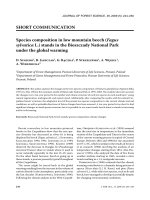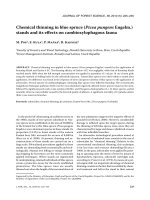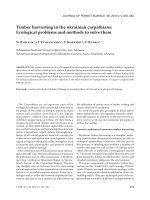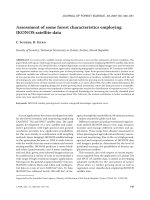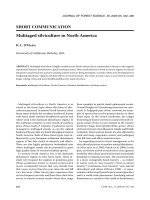Báo cáo lâm nghiệp: " Sampling strategies in forest soils" ppsx
Bạn đang xem bản rút gọn của tài liệu. Xem và tải ngay bản đầy đủ của tài liệu tại đây (418.13 KB, 7 trang )
Note
Sampling
strategies
in
forest
soils
J Fons
T
Sauras
J
Romanyà
VR
Vallejo
1
Forest
Sciences
Department,
University
of British
Columbia,
270-2357
Main
Mall,
Vancouver,
BC,
Canada
V6T 1Z4;
2
Departament
de
Biologia
Vegetal,
Facultat
de
Biologia,
Universitat
de
Barcelona,
Avda
Diagonal
645,
08028
Barcelona,
Spain
(Received
31
August
1995; accepted
2 September
1996)
Summary -
Many
studies
have
revealed
the
high
variability
of
soil
properties,
especially
on
the
forest
floor.
Sampling
techniques
have
been
developed
to
reduce
this
variability
so
as
to
obtain
more
precise
mean
values.
Little
attention
has
been
paid
to
the
frequency
distributions
of
variables,
even
though
they
could
provide
information
on
factors
that
control
variability.
This
paper
addresses
the
selec-
tion
of
the
sampling
strategy
considering
the
type
of
study.
For
the
characterization
of
ecosystems,
stratified
sampling
or
systematic
sampling
is
proposed,
depending
on
previous
knowledge
of
the
study
area.
To
study
processes,
two
cases
were
considered:
processes
that
occur
within
the
ecosys-
tem,
such
as
organic
matter
decomposition,
and
processes
that
concern
the
whole
ecosystem,
such
as
fire.
In
the
first
case
subjective
sampling
was
useful,
since
it
reduced
the
extrinsic
variability
of
the
processes.
In
the
second
case,
both
stratified
and
systematic
sampling
were
very
effective.
Frequency
distribution
analysis
was
proposed
as a
tool
to
detect
some
factors
that
control
litter
accumulation.
forest
floor
/
frequency
distribution
/
subjective
sampling
/
stratified
sampling
/
systematic
sampling
/
variability
Résumé -
Stratégies
d’échantillonnage
dans
les
sols
forestiers.
Beaucoup
d’études
ont
révélé
la
grande
variabilité
des
propriétés
du
sol,
en
particulier
celles
relatives
aux
horizons
organiques.
Plu-
sieurs
techniques
d’échantillonnage
ont
été
développées
pour
réduire
la
variabilité
et
obtenir
des
valeurs
moyennes
avec
précision.
Bien
que
l’étude
des
distributions
de
fréquences
puisse
fournir
des
informations
sur
les
facteurs
qui
contrôlent
la
variabilité,
cette
approche
a
reçu
peu
d’attention.
Cet
article
discute
la
sélection
de
stratégies
d’échantillonnage
selon
le
type
d’étude
à
effectuer.
Pour
la
caractérisation
des
écosystèmes
on
a
proposé
l’échantillonnage
stratifié
ou
l’échnntillonnage
sys-
tématique.
Le
choix
de
l’un
ou
de
l’autre
dépend
de
l’information
disponible
sur
l’aire
d’étude.
Pour
l’étude
de
processus,
deux
cas
ont
été
considérés :
les
processus
à
l’intérieur
de
l’écosystème
(décom-
position
de
la
matière
organique)
et
les
processus
qui
affectent
tout
l’écosystème
(le
feu).
Dans
le
pre-
mier
cas,
l’échantillonnage
dirigé
s’est
montré
approprié
parce
qu’il
réduit
la
variabilité
extrinsèque
*
Correspondence
and
reprints
Tel:
(604)
822
8993;
fax:
(604)
822
5744;
e-mail:
au
processus.
Dans
le
second
cas, les
deux
techniques
d’échantillonnage
(stratifié
et
systématique)
ont
été
efficaces.
L’analyse
de
la
distribution
des
fréquences
a
été jugée
utile
pour
détecter
les
facteurs
qui
contrôlent
l’accumulation
de
la
litière.
Distribution
des
fréquences
/
échantillonnage
dirigé
/
échantillonnage
stratifié
/
échantillonnage
systématique
/
horizons
organiques
/
variabilité
INTRODUCTION
Most
soil
properties
are
highly
variable,
especially
those
of
the
forest
floor
(Blyth
and
Macleod,
1978;
Quesnel
and
Lavkulich,
1980;
Arp
and
Krause,
1984;
Carter
and
Lowe,
1986).
According
to
Allen
and
Hoek-
stra
(1991)
, the
heterogeneity
of natural
sys-
tems
is
caused
by
the
interaction
of
different
processes.
Some
of
these
processes
are
often
of
no
interest
or
not
relevant
to
the
aims
of
the
study,
obscuring
the
effects
of
the
factors
that
are
being
examined.
This
is
a
key
issue
in
ecological
research
considering
that
sam-
pling
design
is
still
one
of
the
least
investi-
gated
aspects
(Orlóci,
1988).
In
practice
most
studies
make
some
assumptions
(ie,
random
samples,
normal
distribution,
etc)
that
are
required
for
common
parametric
statistical
tests.
This
practice
attempts
to
take
advantage
of
the
fact
that
the
more
assumptions
that
are
made,
the
more
infor-
mative
and
reliable
conclusions
are
drawn.
However,
as
noted
by
Seaman
and
Jaeger
(1990),
usual
misuses
and
presumptuous
assumptions
may
weaken
the
results.
Non-
parametric
statistics
avoid
these
problems
and
provide
a
different
kind
of
information
related
to
sample
distribution
and
patterns
(Gibbons,
1985;
Burke
et al,
1988).
Our
objective
was
to
establish
a
guide-
line
for
studies
on
forest
soils
based
on
recent
reviews
on
this
subject
and
data
from
several
studies
in
the
Mediterranean
region.
Specifically
we
focused
on
i)
setting
the
basis
to
determine
the
appropriate
sampling
area
and
sampling
size,
ii)
establishing
a
rationale
for
selecting
the
sampling
strategies
adequate
to
the
aim
of
the
research,
and
iii)
using
nonparametric
techniques
as
a
tool
to
obtain
information
from
variability.
SAMPLING
AREA
Most
studies
approach
the
analysis
of
soil-ecosystem
relationships
(production,
plant
composition,
etc)
using
the
plot
as
a
sampling
unit.
It
is
intended
to
represent
a
particular
ecosystem
or
set
of environmen-
tal
conditions.
Its
area
is
variable,
typically
exceeding
0.01
ha
(Courtin
et
al,
1988;
Sawyer,
1989).
Heterogeneity
within
the
plot
reflects
the
characteristics
of
the
sys-
tem,
but
also
the
author’s
concept
of repre-
sentativity
and
homogeneity.
Literature
on
this
topic
is
scant.
As
an
example,
Blyth
and
Macleod
(1978)
concluded
that
plots
no
smaller
than
0.5
ha
should
be
used
to
study
soil
chemistry.
Another
point
deserving
more
attention
is
the
definition
of
sample
volume
and
sam-
pling
depth.
Changing
any
of
these
may
integrate
the
variability
originated
from
dif-
ferent
factors
that
are
relevant
at
a
given
scale
(Qian
and
Klinka, 1995).
For
instance,
when
studying
the
litter
layer
the
minimum
sample
area
is
derived
from
the
size
of
the
leaves.
As
surface
is
increased
other
factors
are
integrated
and
variability
fluctuates.
Beckett
and
Webster
(1971)
considered
that
1
m2
may
integrate
almost
all
the
variability
in
the
plot.
Two
sample
areas,
380
cm
2
(Sauras,
data
not
published)
and
616
cm
2
(Serrasolsas,
1994),
were
compared
to
esti-
mate
organic
matter
accumulation
in
the
H
horizon
of
a
holm
oak
(Quercus
ilex
L)
for-
est
(table
I).
No
significant
difference
was
observed
in
the
mean
but
the
variance
decreased
as
the
sample
area
increased.
This
is
particularly
interesting
when
working
on
a
plot
level
as
the
results
suggested
that
small
scale
variability
can
be
integrated
by
increasing
sample
area.
SAMPLE
SIZE
Assuming
the
normal
distribution,
a
set
of
formulas
are
available
to
calculate
the
num-
ber
of
samples
needed
for
a
given
power
of
test
or
error
estimation
(Zar,
1984).
The
problem
is
that,
under
field
conditions,
the
amount
of
samples
to
be
collected
is
usu-
ally
beyond
the
possibilities
of
the
study
(table
II).
An
alternative
criterion
could
be
based
on
the
relationship
between
sample
size
and
variability,
whatever
the
distribu-
tion.
In
the
case
of
organic
matter
accumu-
lation
on
the
forest
floor,
variability
stabi-
lized
around
16
samples
and
it
was
independent
from
the
type
of
sampling
(fig
1).
Collecting
more
samples
would
increase
the
power
of
statistical
tests
but
the
variability
of
the
system
would
already
have
been
integrated
within
16
samples.
Composite
samples
make
it
possible
to
decrease
the
number
of
samples
to
be
ana-
lyzed.
The
result
is
a
certain
decrease
in
within-site
variability
and
lower
precision,
but
this
may
not
be
significant
at
an
ecosys-
tem
level
(Carter
and
Lowe,
1986).
Com-
posite
samples
are
particularly
useful
for
nutrient
studies
as
soil
physical
properties
usually
are
more
variable
and
require
a
greater
number
of
samples
than
chemical
properties
(Arp
and
Krause,
1984).
SAMPLING
STRATEGIES
The
objectives
of
the
study
are
to
determine
the
sampling
strategy
since
the
technique
used
strongly
influences
the
information
acquired
(Orlóci,
1988).
We
have
consid-
ered
two
groups
of
studies.
Characterization
of
ecosystems
To
characterize
an
ecosystem,
its
intrinsic
variability
must
be
integrated
(Orlóci,
1988).
It
may
be
accomplished
by
systematic
and
stratified
sampling.
If
there
is
no
specific
spatial
pattern,
systematic
sampling
is
rec-
ommended
because
it
ensures
a
better
cov-
erage
of
the
population
than
random
samples
(Petersen
and
Calvin,
1986).
Stratified
sampling
is
one
of
the
most
precise
sampling
strategies
(Petersen
and
Calvin,
1986),
but
it
requires
previous
infor-
mation
on
the
system
for
separating
the
object
of
study
into
component
parts.
Its
effectiveness
is
due
to
the
sampling
error
arising
solely
from
variations
within
com-
ponents
and
not
between
them.
Then,
the
effectiveness
of
the
stratified
design
depends
on
the
relevancy
of
the
criterion
adopted
for
the
selection
of
components
in
the
system.
A
study
on
litter
accumulation
in
Pinus
halepensis
Mill
stands
(Fons,
1995),
revealed
that
error
obtained
with
a
stratified
sampling
based
on
the
litter
type
within
each
plot
(pine
litter
and
other
species
litter)
was
lower
than
random
sampling
(table
III).
Stratified
sampling
reduced
variability
by
1
5 to
20%
and
therefore
the
number
of
sam-
ples
can
be
reduced
by
an
equivalent
per-
centage
(Sokal
and
Rohlf,
1981).
Studying
processes
Processes
in
the
system
It
is
desirable
to
bypass
any
variability
extrinsic
to
the
process
and
control
as
much
as
possible
all
factors
affecting
it.
Subjective
sampling
(also
called
judgement
or
prefer-
ential
sampling)
allows
us
to
eliminate
unde-
sirable
factors
by
considering
only
samples
from
specific
areas
of
the
system
(Crepin
and
Johnson,
1993).
Vallejo
et
al
(1990),
studying
the
incorporation
and
cycling
of
radionuclides
from
the
Chernobyl
accident
in
forest
ecosystems,
selected
only
samples
from
under
dense
canopies
and
in
sites
with
well-developed
forest
floors.
In
a
parallel
experiment
on
radionuclide
migration
in
the
forest
floor,
samples
were
taken
50
cm
from
trees
either
to
the
right
or
to
the
left
follow-
ing
the
level line
(Sauras
et
al,
1992).
A
sys-
tematic
sampling
in
the
same
plots
(Arias
et
al,
1991 ),
showed
higher
variability
(table
IV).
Therefore,
the
subjective
sam-
pling
allowed
us
to
limit
the
variability
in
the
process
of
interest,
and
diminished
the
variability
caused
by
other
factors
extrane-
ous
to
this
process.
Changes
in
the
whole
system
When
studying
changes
in
the
whole
sys-
tem,
such
as
fire
disturbances,
it
is
neces-
sary
to
consider
all
sources
of
variability
in
the
system.
Then,
as
in
characterizing
ecosystems,
systematic
and
stratified
sam-
pling
are
the
most
suitable
strategies.
When
the
heterogeneity
of
the
area
is
readily
rec-
ognizable
a
priori,
stratified
sampling
is
the
most
appropriate.
For
example,
Romanyà
et
al
(1994),
studying
the
effects
of
fire
on
soil
phosphorus
availability,
surveyed
the
area
prior
to
sampling
using
the
line-tran-
sect
method.
According
to
the
intensity
of
fire
the
site
was
divided
into
four
strata
(fig
2).
Areas
heavily
pertubated
by
logging
operations
were
avoided,
thus
the
study
only
included
ash
bed,
burnt
and
unburnt
areas.
In
each
studied
stratum
systematic
sampling
was
carried
out
and
each
stratum
was
stud-
ied
separately.
Finally,
to
describe
the
global
effects
of
fire
on
soil
phosphorus
pools,
results
were
integrated
considering
the
mag-
nitude
of
the
effects
and
the
relative
surface
of
each
stratum.
ANALYSIS
OF
VARIABILITY
A
study
on
litter
accumulation
illustrated
the
usefulness
of frequency
distribution
anal-
ysis
detecting
some
patterns.
The
effect
of
slope
position
(upper,
mid-
dle
and
bottom)
and
aspect
(N
and
S)
on
lit-
ter
accumulation
was
studied
in
Pinus
halepensis
Mill
forests
(Fons,
1995).
At
each
combination,
two
plots
were
selected
(16
samples
per
plot),
analysis
of variance
(ANOVA)
revealed
only
differences
between
plots,
and
lack
of
significance
on
slope
position
and
aspect
was
attributed
to
high
variability.
The
analysis
of
frequency
distributions
revealed
two
different
groups
(Kolmogorov-Smirnov
test):
i)
top
and
medium
S
facing
slope,
ii)
N
aspect
and
bot-
tom
S
facing
slope
(fig
3).
Standard
devia-
tion,
skewness
and
kurtosis
were
higher
in
the
first
group
and
data
did
not
fit
a
normal
distribution.
However,
the
data
of
the
second
group
fitted
a
normal
distribution
(logN
for
bottom
S
facing
aspect).
It
can
be
concluded
that
the
slope
position
had
a
significant
effect
in
litter
accumulation:
heterogeneity
was
lower
on
the
N
aspect
and
the
maxi-
mum
differences
between
distributions
were
detected
between
the
N
and
the
S
aspect
on
the
middle
slope,
decreasing
on
the
bottom.
In
addition,
differences
between
distribu-
tions
were
caused
by
differences
in
higher
litter
accumulation
(points
over
20
Mg·ha
-1
in
fig
3).
CONCLUSIONS
The
study
of variability
is
useful
to
obtain
an
optimum
experimental
design
and
an
opti-
mum
allocation
of
resources
in
forest
soil
studies.
Minimizing
variability
may
be
prac-
tical
when
the
aim
of
the
study
is
to
increase
precision
in
measurements
and
resolution
in
discriminating
between
treatments,
oth-
erwise
variability
can
be
seen
as a
source
of
information
and
used
to
describe
ecosys-
tems.
In
this
case
minimizing
variability
may
be
a
strategy
of
no
interest.
ACKNOWLEDGMENTS
We
thank
the
Group
of
Forest
Soils
(Dep
Biolo-
gia
Vegetal,
Universitat
de
Barcelona)
and
two
anonymous
reviewers
for
helpful
comments
on
the
manuscript.
This
work
has
been
partially
sup-
ported
by
the
EC
Program
Environment
(EV5V-
CT 92-0141
).
REFERENCES
Allen
TFH,
Hoekstra
TW
(1991)
Role
of
heterogene-
ity
in
scaling
of ecological
systems
under
analy-
sis.
In:
Ecological
Heterogeneity. Systems
Under
Analysis.
Ecological
Studies
No 86
(J
Kolasa,
ST
Pickett,
eds),
Springer-Verlag,
New
York,
NY,
USA
Arias
JJ,
Scrrisolsas
I,
Vallejo
VR,
Alcañiz
JM,
Josa
R,
Sole
A ( 1991 )
The
Effects
of
Clearcutting
and
Fire
on
the
Forest
Soils
of Prades
Mountains
(La
Conca
de
Barberà).
EC
Report
EV4V-0109
Arp
PA,
Krause
HH
(1984)
The
forest
floor:
lateral
variability
as
revealed
by
systematic
sampling.
Can
J
Soil
Sci
64,
423-437
Beckett
PTH,
Webster
R
(1971)
Soil
variability:
a
review. Soils
Fertil 34,
1-15
Blyth
JP, Macleod
DA
(1978)
The
significance
of soil
variability
for
forest
soil
studies
in
North-East
Scot-
land.
J
Soil
Sci
29,
419-430
Burke
PV, Bullen
BL, Poff KL
(1988)
Frequency
dis-
tribution
histograms
for
the
rapid
analysis
of data.
Plant
Physiol 87,
797-798
Carter
RE,
Lowe
LE
(1986)
Lateral
variability
of
for-
est
floor
properties
under
second-growth
Douglas-
fir
stands
and
the
usefulness
of
composite
sampling
techniques.
Can
J
For
Res
16,
1128-1132
Courtin
PJ,
Klinka
K,
Feller
MC,
Demaerschalk
JP
(1988)
An
approach
to
quantitative
classification
of
nutrient
regimes
of
forest
soils.
Can
J
Bot
66,
2640-2653
Crepin
J,
Johnson
RL
(1993)
Soil
sampling
for
envi-
ronmental
assessment.
In:
Soil
Sampling
and
Meth-
ods of Analysis
(MR
Carter,
ed),
Lewis
Publish-
ers,
Boca
Raton,
FL,
USA,
5-18
Fons
J
(1995)
Avaluació de
la
Fertilitat
en
Sòls
Fore-
stals
Mediterranis.
El
Cas
de
les
Pinedes
de
Pi
Blanc
(Pinus
halepensis
Mill).
PhD
thesis,
Universitat
de
Barcelona,
Barcelona,
Spain
Gibbons
JD
(1985)
Nonparametric Statistical Infer-
ence.
Marcel
Dekker,
Inc,
New
York,
NY,
USA
Llaurado
M,
Vidal
M,
Rauret
G,
Roca
MC,
Fons
J,
Vallejo
VR
(1994)
Radiocaesium
behaviour
in
Mediterranean
conditions.
J Environ
Radioactiv-
ity 23, 81-100
Orlóci
L
(1988)
Community
organization:
recent
advances
in
numerical
methods.
Can
J
Bot
66.
2626-2633
Petersen
RG,
Calvin
LD
(1986)
Sampling.
In:
Methods
of Soil
Analysis.
I.
Physical
and
Mineralogical
Methods
(A
Klute,
ed),
American
Society
of
Agron-
omy,
Soil
Science
Society
of
America,
Madison,
WI,
USA,
33-51
Quesnel
HJ,
Lavkulich
LM
(1980)
Nutrient
variability
of
forest
floor
near
Port
Hardy,
British
Columbia,
Canada.
Can
J
Soil
Sci
60,
565-573
Qian
H,
Klinka
K
(1995)
Spatial
variability
of humus
forms
in
some
coastal
forest
ecosystems.
Ann
Sci
For
52,
653-666
Romanyà
J,
Khanna
PK,
Raison
JR
(1994)
Effects
of
slashburning
on
soil
phosphorus
fractions
and
sorp-
tion
and
desorption
of
phosphorus.
For
Ecol
Man-
age 65, 89-103
Sauras
T,
Roca
MC,
Vallejo
VR,
Tent
J,
Llaurado
M,
Vidal
M,
Rauret
G
(1992)
Migration
study
of
radionuclides
in
Mediterranean
forest
soils
using
synthetic
aerosols.
Seminar
on
the
dynamic
behav-
ior
of
radionuclides
in
forests.
Stockholm,
Swe-
den,
May
1992
Sawyer
AL
(1989)
Inconstancy
of
Taylor’s
b:
simu-
lated
sampling
with
different
quadrat
sizes
and
spa-
tial
distributions.
Res
Popul
Ecol
31,
11-24
Seaman
JW.
Jaeger
RG
(1990)
Statisticae
dogmati-
cae:
a
critical
essay
on
statistical
practice
in
ecology.
Herpetologie
46, 337-346
Serrasolsas
I
(1994)
Fertilitat
dels
sòls forestals
afec-
tats
pels foc.
Dinàmica
del nitrogen
i el fòsfor.
PhD
thesis,
Universitat
de
Barcelona,
Barcelona,
Spain
Snedecor
GW.
Cochran
WG
( 1991 )
Statistical
Meth-
ods.
Iowa
State
University
Press,
Iowa,
USA
Sokal
RR,
Rohlf RJ
(1981)
Biometry.
Freeman,
San
Francisco,
CA.
USA
Vallejo
VR,
Roca
MC,
Fons
J,
Rauret
G,
Llaurado
M,
Vidal
M
(1990)
Radiocaesium
transfer
in
Mediter-
ranean
forest
ecosystems.
In:
Proceedings
of the
Workshop
on
"Transfer
of Radionuclides
in
Natu-
ral and
Semi-Natural
Environments"
ECSC,
EEC,
EAEC, Elsevier
Science
Publishers
LTD,
103-109
Zar JH
(1984)
Biostatistical
Analysis.
Prentice
Hall
Inc.
Englewood
Cliffs,
NJ,
USA



